SUBMERGENCE VILLAGE SONDUL, MADHYA PRADESH
~2 minutes
“…The wood sellers used to go to the Nisarpur market to sell wood. They would also pack and tie fodder in bundles and take them there to be sold. We used to ferry them across to the market and ferry them back, along with the supplies that they would buy from the market. We used to row them across the Narmada River and take them to the market. They used to bring anjan fodder from the mountains. They used to carry wood, charcoal – everything to the market …Boats plied from Rajghat too. At Rajghat, jeeps, motorcycles, cars were all ferried by boats across the river. Earlier, there was no bridge at Rajghat. So, the boatmen at Rajghat used to earn a good income, the boats were rowed throughout the day…”
Chaganbhai Kevat
The Kevat community earn their livelihood by ferrying passengers and goods across the river Narmada in their boats. Chaganbhai, a Kevat himself, explains how the Kevats and other communities of his village Sondul lived on the banks of the Narmada River. The livelihoods of the Kevat community, like the Kahar community, are directly linked to the river Narmada and so it is important to understand that any disruption in the river affects these communities the most. And any land or cash based compensation for their displacement by a dam is grossly inadequate.
The photographs used in this clip are those of the Narmada River and the boats are those used both in the upstream and downstream of the Sardar Sarovar Dam.

Interview Duration:
00:30:00
Language:
Hindi , Subtitles in English
Subtitles can be switched on and off by clicking ‘CC’ button at the bottom right of the video